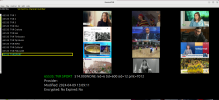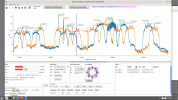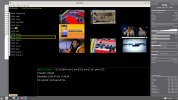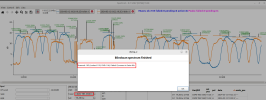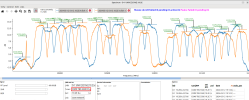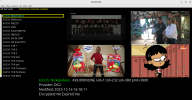- Forums
- Satellite TV receivers & systems support forums
- Satellite PC Card Receivers, Internet by Satellite
You are using an out of date browser. It may not display this or other websites correctly.
You should upgrade or use an alternative browser.
You should upgrade or use an alternative browser.
neumoDVB
- Thread starter deeptho
- Start date
Satspot
Member
- Joined
- Sep 3, 2021
- Messages
- 602
- Reaction score
- 205
- Points
- 43
- Age
- 62
- My Satellite Setup
-
Technomate TM5402 M4
1.2m Triax dish
Technomate H to H motor
- My Location
- Ireland

Pin or retain a kernel version (or increase the number of kernels retained)
For Silverblue, you can instruct rpm-ostree to maintain a specific version of a given layered package or even a core package of the base ostree. You would use the override command with either the replace remove or reset option(s) for this. ie. rpm-ostree override replace (packagename) (desired...
 discussion.fedoraproject.org
discussion.fedoraproject.org
satesco
Specialist Contributor
- Joined
- Aug 10, 2008
- Messages
- 2,181
- Reaction score
- 3,160
- Points
- 113
- My Satellite Setup
-
seven antennas,one toroidal with 16 lnbs,
6 satellite receivers,2 Meters,9 PC cards(tbs6983,6903,6590,6504,6522,6209,2603,6909X,6903X,6902se,skystar hd2),2 tuners usb-tbs5927 & tbs5925,Skystar HD.
Satellite reception between 100.5E-50.0W
- My Location
- Romania
I also thought it was a signal problem when I first tried to scan terrestrially, to no avail, after neumoDVB's update two months ago. Still, I didn't know that the app was updated three weeks ago, probably expressly to fix the terrestrial scan....
Same in updateDVB scans OK so not a signal issue.
After updating neumoDVB today, I managed to find the terrestrial services.

So it wasn't a signal problem.
Attachments
deeptho
Specialist Contributor
- Joined
- Apr 7, 2006
- Messages
- 768
- Reaction score
- 465
- Points
- 63
- Age
- 57
- My Satellite Setup
- Wavefrontier T90, Laminas 120cm, 2 other dishes; tbs 5927, tbs6904, tbs6909x, tbs6903x, tbs5990, tbs6981,tbs5927
- My Location
- Europe
I have updated the drivers to support kernel 6.8., No new functionality...
- Joined
- Jan 1, 2000
- Messages
- 16,259
- Reaction score
- 4,217
- Points
- 113
- Age
- 82
- My Satellite Setup
-
Triple Dragon, Dreambox 8000, Echostar AD3000ip, TBS6522,6925,6983 PCie cards.
Gibertini 1.25m motorised dish driven by the AD3000, with either Inverto BU Quad or Norsat / XMW Ka LNBs . SMW 1.05m + 3 other dishes. Speccy: Promax HD Ranger+
- My Location
- The Flatlands of East Anglia
What are you using to scan with satesco?I also thought it was a signal problem when I first tried to scan terrestrially, to no avail, after neumoDVB's update two months ago. Still, I didn't know that the app was updated three weeks ago, probably expressly to fix the terrestrial scan.
After updating neumoDVB today, I managed to find the terrestrial services.
So it wasn't a signal problem.
Update didn't fix my DVB-T problem.
I've been trying with the TBS 6522 with no luck. Only works with the Sony USB stick.
I have a TBS 6220 in my other PC, but that only has Windows.
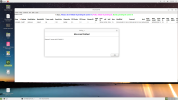
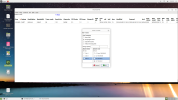
satesco
Specialist Contributor
- Joined
- Aug 10, 2008
- Messages
- 2,181
- Reaction score
- 3,160
- Points
- 113
- My Satellite Setup
-
seven antennas,one toroidal with 16 lnbs,
6 satellite receivers,2 Meters,9 PC cards(tbs6983,6903,6590,6504,6522,6209,2603,6909X,6903X,6902se,skystar hd2),2 tuners usb-tbs5927 & tbs5925,Skystar HD.
Satellite reception between 100.5E-50.0W
- My Location
- Romania
- Joined
- Jan 1, 2000
- Messages
- 16,259
- Reaction score
- 4,217
- Points
- 113
- Age
- 82
- My Satellite Setup
-
Triple Dragon, Dreambox 8000, Echostar AD3000ip, TBS6522,6925,6983 PCie cards.
Gibertini 1.25m motorised dish driven by the AD3000, with either Inverto BU Quad or Norsat / XMW Ka LNBs . SMW 1.05m + 3 other dishes. Speccy: Promax HD Ranger+
- My Location
- The Flatlands of East Anglia
OK, thanks. Must be TBS T/T2 card specific.You're right, @Llew; I should have mentioned the 6504 card I used for terrestrial scanning with neumoDVB.
If I get a chance, I'll try the TBS 6220 in the PC, or better still put a Linux OS in the other one.
satesco
Specialist Contributor
- Joined
- Aug 10, 2008
- Messages
- 2,181
- Reaction score
- 3,160
- Points
- 113
- My Satellite Setup
-
seven antennas,one toroidal with 16 lnbs,
6 satellite receivers,2 Meters,9 PC cards(tbs6983,6903,6590,6504,6522,6209,2603,6909X,6903X,6902se,skystar hd2),2 tuners usb-tbs5927 & tbs5925,Skystar HD.
Satellite reception between 100.5E-50.0W
- My Location
- Romania
RyLe
Member
- Joined
- Sep 14, 2011
- Messages
- 31
- Reaction score
- 5
- Points
- 8
- Age
- 44
- Location
- France
- My Satellite Setup
-
Wavefrontier T90, 8W to 28.2E
TBS 6909-X, TBS 6904SE, TBS 6983
- My Location
- France
Hi
I just upgraded to Fedora 40 (currently with 6.8.7-300.fc40.x86_64 Kernel).
When I tried to build the blindscan kernel drivers, I had an error:
I bypassed it by adding
Probably not pretty but it works for now.
I just upgraded to Fedora 40 (currently with 6.8.7-300.fc40.x86_64 Kernel).
When I tried to build the blindscan kernel drivers, I had an error:
/home/ryle/blindscan_kernel/media_build/v4l/tbs5931.c:217:90: error: passing argument 3 of '__a' makes integer from pointer without a cast [-Wint-conversion]
217 | adap->fe_adap->fe = dvb_attach(tas2101_attach,&gx1132_cfg, &d->i2c_adap, adapter_nr);
| ^~~~~~~~~~
| |
| short int *
I bypassed it by adding
EXTRA_CFLAGS += -Wno-int-conversion to/home/ryle/blindscan_kernel/media_build/v4l/MakefileProbably not pretty but it works for now.
deeptho
Specialist Contributor
- Joined
- Apr 7, 2006
- Messages
- 768
- Reaction score
- 465
- Points
- 63
- Age
- 57
- My Satellite Setup
- Wavefrontier T90, Laminas 120cm, 2 other dishes; tbs 5927, tbs6904, tbs6909x, tbs6903x, tbs5990, tbs6981,tbs5927
- My Location
- Europe
Probably the correct fix is to replace adapter_nr by rf_in (which is zero). I would not change the compilation flags as that will be one more source of errors in futureHi
I just upgraded to Fedora 40 (currently with 6.8.7-300.fc40.x86_64 Kernel).
When I tried to build the blindscan kernel drivers, I had an error:
/home/ryle/blindscan_kernel/media_build/v4l/tbs5931.c:217:90: error: passing argument 3 of '__a' makes integer from pointer without a cast [-Wint-conversion] 217 | adap->fe_adap->fe = dvb_attach(tas2101_attach,&gx1132_cfg, &d->i2c_adap, adapter_nr); | ^~~~~~~~~~ | | | short int *
I bypassed it by addingEXTRA_CFLAGS += -Wno-int-conversionto
/home/ryle/blindscan_kernel/media_build/v4l/Makefile
Probably not pretty but it works for now.
bredhitman
Member
- Joined
- Dec 10, 2023
- Messages
- 35
- Reaction score
- 1
- Points
- 8
- Age
- 54
- My Satellite Setup
- viark sat 4k
- My Location
- Germany
Which tv channels are encrypted with rosscrypt or Rosscrypt2 and is there a Conditional access cam for it??It could be signal levels, but also some of these services are encrypted in rosscrypt, which appears as pixellated images.
Only with log files I can do anything about the remaining errors.
The muxes are distributed by Gazprom. What would be really interesting would be to access the uplink. That would allow btinging some news from the real world into that country.
No
- Joined
- Jan 1, 2000
- Messages
- 16,259
- Reaction score
- 4,217
- Points
- 113
- Age
- 82
- My Satellite Setup
-
Triple Dragon, Dreambox 8000, Echostar AD3000ip, TBS6522,6925,6983 PCie cards.
Gibertini 1.25m motorised dish driven by the AD3000, with either Inverto BU Quad or Norsat / XMW Ka LNBs . SMW 1.05m + 3 other dishes. Speccy: Promax HD Ranger+
- My Location
- The Flatlands of East Anglia
Latest Ubuntu 24.04 LTS.
Kernel 6.8 crashes my system (AMD with Radeon graphics) - messed-up screen with password unrecognised.
Compiles OK with kernel dropped down to 6.5.
Same software requisites as with Ubuntu 23.10, but with clang 18.
Kernel 6.8 crashes my system (AMD with Radeon graphics) - messed-up screen with password unrecognised.
Compiles OK with kernel dropped down to 6.5.
Same software requisites as with Ubuntu 23.10, but with clang 18.
Attachments
satesco
Specialist Contributor
- Joined
- Aug 10, 2008
- Messages
- 2,181
- Reaction score
- 3,160
- Points
- 113
- My Satellite Setup
-
seven antennas,one toroidal with 16 lnbs,
6 satellite receivers,2 Meters,9 PC cards(tbs6983,6903,6590,6504,6522,6209,2603,6909X,6903X,6902se,skystar hd2),2 tuners usb-tbs5927 & tbs5925,Skystar HD.
Satellite reception between 100.5E-50.0W
- My Location
- Romania
I'm waiting to see what @deeptho's answer is about the kernel crash on Ubuntu 24.04 LTS.Latest Ubuntu 24.04 LTS.
Kernel 6.8 crashes my system (AMD with Radeon graphics) - messed-up screen with password unrecognised.
Compiles OK with kernel dropped down to 6.5.
Same software requisites as with Ubuntu 23.10, but with clang 18.
I'm still working with version 23.10 and have no problems with neumoDVB, but since my version is transitional, so to speak, I'm thinking of the latest LTS, i.e., 24.04.

deeptho
Specialist Contributor
- Joined
- Apr 7, 2006
- Messages
- 768
- Reaction score
- 465
- Points
- 63
- Age
- 57
- My Satellite Setup
- Wavefrontier T90, Laminas 120cm, 2 other dishes; tbs 5927, tbs6904, tbs6909x, tbs6903x, tbs5990, tbs6981,tbs5927
- My Location
- Europe
Llew, no idea.Latest Ubuntu 24.04 LTS.
Kernel 6.8 crashes my system (AMD with Radeon graphics) - messed-up screen with password unrecognised.
Compiles OK with kernel dropped down to 6.5.
Same software requisites as with Ubuntu 23.10, but with clang 18.
satesco
Specialist Contributor
- Joined
- Aug 10, 2008
- Messages
- 2,181
- Reaction score
- 3,160
- Points
- 113
- My Satellite Setup
-
seven antennas,one toroidal with 16 lnbs,
6 satellite receivers,2 Meters,9 PC cards(tbs6983,6903,6590,6504,6522,6209,2603,6909X,6903X,6902se,skystar hd2),2 tuners usb-tbs5927 & tbs5925,Skystar HD.
Satellite reception between 100.5E-50.0W
- My Location
- Romania
A friend asked me to test the TBS5580 USB Tuner(S/C/T) with neumoDVB.
Luckily, @deeptho's driver recognized the USB immediately, and the app scanned it without problems.
I thought I'd post the test result for those wanting or have this device.
@Llew,
What is the situation with kernel 6.5 with Ubuntu04 LTS?
Did you manage to work with neumoDVB under 24.04 LTS?
Thanks
Luckily, @deeptho's driver recognized the USB immediately, and the app scanned it without problems.
I thought I'd post the test result for those wanting or have this device.
@Llew,
What is the situation with kernel 6.5 with Ubuntu04 LTS?
Did you manage to work with neumoDVB under 24.04 LTS?
Thanks

Attachments
- Joined
- Jan 1, 2000
- Messages
- 16,259
- Reaction score
- 4,217
- Points
- 113
- Age
- 82
- My Satellite Setup
-
Triple Dragon, Dreambox 8000, Echostar AD3000ip, TBS6522,6925,6983 PCie cards.
Gibertini 1.25m motorised dish driven by the AD3000, with either Inverto BU Quad or Norsat / XMW Ka LNBs . SMW 1.05m + 3 other dishes. Speccy: Promax HD Ranger+
- My Location
- The Flatlands of East Anglia
Yes satesco, that spectrum scan in my post above was taken in Ubuntu 24.04 LTS.What is the situation with kernel 6.5 with Ubuntu04 LTS?
Did you manage to work with neumoDVB under 24.04 LTS?
Thanks
I chose kernel 6.5, but I would assume any kernel below 6.8 would suffice (still don't know what the problem is with that kernel in Ubuntu).
Download a kernel package (amd64) from Index of /mainline and dpkg the debs to your PC.
Last edited:
deeptho
Specialist Contributor
- Joined
- Apr 7, 2006
- Messages
- 768
- Reaction score
- 465
- Points
- 63
- Age
- 57
- My Satellite Setup
- Wavefrontier T90, Laminas 120cm, 2 other dishes; tbs 5927, tbs6904, tbs6909x, tbs6903x, tbs5990, tbs6981,tbs5927
- My Location
- Europe
Good to hear that it work. I will add it to the readme. I am currently working on improviing the drivers for stid135, mainly to support tbs6916 which has 16 tuners, but it may also improve scanning on tbs6909xYes satesco, that spectrum scan in my post above was taken in Ubuntu 24.04 LTS.
I chose kernel 6.5, but I would assume any kernel below 6.8 would suffice (still don't know what the problem is with that kernel in Ubuntu).
Download a kernel package (amd64) from Index of /mainline and dpkg the debs to your PC.
deeptho
Specialist Contributor
- Joined
- Apr 7, 2006
- Messages
- 768
- Reaction score
- 465
- Points
- 63
- Age
- 57
- My Satellite Setup
- Wavefrontier T90, Laminas 120cm, 2 other dishes; tbs 5927, tbs6904, tbs6909x, tbs6903x, tbs5990, tbs6981,tbs5927
- My Location
- Europe
I have been testing neumoDVB with tbs6916. This is a card with 4 RF input connectors and 8 tuners and 16 demodulators incorporating 2 STID chips. it can deliver 16 full transport streams from 16 muxes on 4 satellite bands simultaneously. With neumoDVB 16 or more services can then be tuned simultaneously from all of these muxes.
New drivers were needed to handle conflicts between the tuners, as they share the LNBs and should be careful not
to make contradictory decisions regarding sending 22kHz to switch between high and low bands or to send conflicting
diseqc commands.
neumoDVB itself still needs some modifications to make use from this, but by being careful in starting the muxes (not all at once), it can already working. Here is a screenshot showing 18 services from 16 muxes selected from 52E, 30W, 19.2E and 28.2E.
To add to the complexity, neumoDVB itself was running on a remote computer and all of this was streamed over WIFI.
It works, but the frame rate was not great.
The code needs some more work before releasing it
The new code also can show useful information about the internal state of the drivers via sysfs
This shows that all 4 rf_inputs are in use on 4 LNB connections. use_count is the number of demods
connected to an rf_in. The total is 16, showing that all demods are in use. All rf_inputs, except 2, are controlled
by the first stid135 chip, which means that this chip is responsible for diseqc and 22kHz sending. Voltages are controlled
by the FPGA on the card.
So on the first chip only 3 tuners were in use
On the second chip only 2 tuners were in use.
neumoDVB and the drivers decide which tuners to use. As there are only 4 input bands, there is no need to
use more than 4 tuners, except when all demods on one chip are fully used and the second chip comes in action.
Then more tuners must be started...
New drivers were needed to handle conflicts between the tuners, as they share the LNBs and should be careful not
to make contradictory decisions regarding sending 22kHz to switch between high and low bands or to send conflicting
diseqc commands.
neumoDVB itself still needs some modifications to make use from this, but by being careful in starting the muxes (not all at once), it can already working. Here is a screenshot showing 18 services from 16 muxes selected from 52E, 30W, 19.2E and 28.2E.
To add to the complexity, neumoDVB itself was running on a remote computer and all of this was streamed over WIFI.
It works, but the frame rate was not great.

The code needs some more work before releasing it
The new code also can show useful information about the internal state of the drivers via sysfs
Code:
$cat /sys/module/stid135/card0/state
card_no = 0 dev =00000000a81f1a57
use_count = 2
chips: 0000000064275c6e 00000000dc378979
rf_in[0]: use_count=4 owner=-1 controller=0 voltage=0 tone=1
rf_in[1]: use_count=3 owner=-1 controller=0 voltage=1 tone=1
rf_in[2]: use_count=4 owner=-1 controller=1 voltage=1 tone=1
rf_in[3]: use_count=5 owner=-1 controller=0 voltage=0 tone=1
====connected to an rf_in. The total is 16, showing that all demods are in use. All rf_inputs, except 2, are controlled
by the first stid135 chip, which means that this chip is responsible for diseqc and 22kHz sending. Voltages are controlled
by the FPGA on the card.
Code:
cat /sys/module/stid135/card0/chip0/state
card_no=0 chip_no=0 addr=0x68 i2c=00000000b5b88f76
use_count = 8 mutex_locked_by=-1 at FE_STiD135_GetBer:1518
tuner[0]: use_count=4 power=1 active_rf_in=0
rf_in_use_count=4 voltage=13V tone=off
vglna=0 control_22k=1
tuner[1]: use_count=3 power=1 active_rf_in=1
rf_in_use_count=3 voltage=18V tone=off
vglna=0 control_22k=1
tuner[2]: use_count=0 power=0 active_rf_in=-1
vglna=0 control_22k=1
tuner[3]: use_count=1 power=1 active_rf_in=3
rf_in_use_count=5 voltage=13V tone=off
vglna=0 control_22k=1
Code:
$cat /sys/module/stid135/card0/chip1/state
card_no=0 chip_no=1 addr=0x68 i2c=00000000abb9b0e1
use_count = 8 mutex_locked_by=-1 at FE_STiD135_GetBer:1518
tuner[0]: use_count=0 power=0 active_rf_in=-1
vglna=0 control_22k=0
tuner[1]: use_count=0 power=0 active_rf_in=-1
vglna=0 control_22k=0
tuner[2]: use_count=4 power=1 active_rf_in=2
rf_in_use_count=4 voltage=18V tone=off
vglna=0 control_22k=0
tuner[3]: use_count=4 power=1 active_rf_in=3
rf_in_use_count=5 voltage=13V tone=off
vglna=0 control_22k=0neumoDVB and the drivers decide which tuners to use. As there are only 4 input bands, there is no need to
use more than 4 tuners, except when all demods on one chip are fully used and the second chip comes in action.
Then more tuners must be started...
nighthawk77
Member
- Joined
- Sep 10, 2009
- Messages
- 7
- Reaction score
- 0
- Points
- 1
- Age
- 47
- My Satellite Setup
- 110cm dish-humax-diablo
- My Location
- bosnia&herzegovina
Glad to see that this project is developing. Linux deserves to have dvb software like this, although I'm still struggling to compile it on Debian12 (stuck at 83%). So for now Kaffeine is the only option for me on linux environment.


